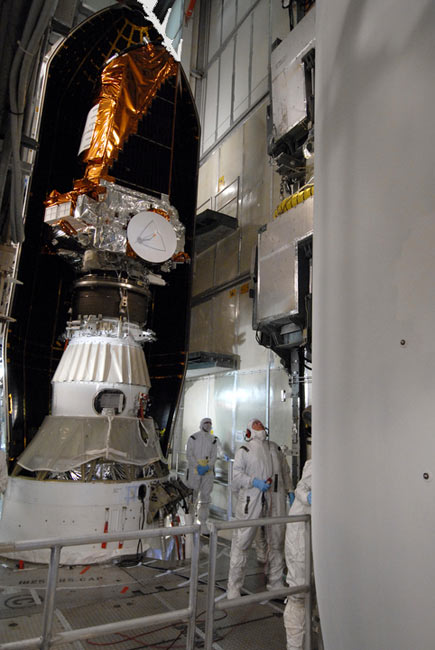NASA Delays Planet-Hunting Mission a Day for Rocket Checks

This story was updated at 1:33 p.m. EST.
NASA has delayedthe planned launch of its new planet-hunting Kepler spacecraft next week by oneday to allow time for extra rocket checks after the agency?s latest satellitecrashed into ocean on Tuesday.
The nearly $600million Kepler mission is now slated to blast off from the Cape CanaveralAir Force Station in Florida on March 6 at 10:49 p.m. EST (0349 March 7 GMT),NASA officials announced late Thursday.
The extraday gives NASA engineers more time to double check systems on the protectiveclamshell-like shroud at the nose of the Kepler spacecraft?s Delta 2 rocket toensure they will work properly. Kepler is a space telescope built to searchfor Earth-like planets in orbit around other stars.
On Tuesday,NASA?s $273.4 million Orbiting Carbon Observatory plungedinto the ocean near Antarctica when the payload shroud of its Taurus XLrocket failed to separate as designed about three minutes after launching fromCalifornia?s Vandenberg Air Force Base. NASA is forming a mishapinvestigation board to root out the exact cause of the failed launch.
The TaurusXL rocket is built by Dulles, Va.-based Orbital Sciences, Corp., and Kepler?sDelta 2 booster is built by the joint United Launch Alliance. But NASA wants tobe extra sure Kepler and its Delta 2 rocket will not suffer the same fate asthe lost Orbiting Carbon Observatory despite having a different manufacturer.
?They wantto look at all the systems and check any similarities between the Delta 2 andTaurus rockets,? NASA spokesperson Tracy Young said Friday from the agency?sKennedy Space Center near Kepler?s launch site.
Get the Space.com Newsletter
Breaking space news, the latest updates on rocket launches, skywatching events and more!
Young told SPACE.comthat Kepler mission managers have postponed a planned Saturday meeting todiscuss whether the spacecraft is ready for flight until Monday. If all is wellthen, Kepler will be cleared for a late Friday launch, she added.
The Keplerspacecraft is expected to spend at least 3 1/2 years searching a 3,000light-year target zone for signs ofextrasolar planets about the size of Earth or larger. To date, more than300 extrasolar planets have been discovered circling stars in our Milky Way galaxy,most of them the size of Jupiter or larger.
- Video- A World Like Our Own
- Top 10Most Intriguing Extrasolar Planets
- Video- Planet Hunter
Join our Space Forums to keep talking space on the latest missions, night sky and more! And if you have a news tip, correction or comment, let us know at: community@space.com.

Tariq is the Editor-in-Chief of Space.com and joined the team in 2001, first as an intern and staff writer, and later as an editor. He covers human spaceflight, exploration and space science, as well as skywatching and entertainment. He became Space.com's Managing Editor in 2009 and Editor-in-Chief in 2019. Before joining Space.com, Tariq was a staff reporter for The Los Angeles Times covering education and city beats in La Habra, Fullerton and Huntington Beach. In October 2022, Tariq received the Harry Kolcum Award for excellence in space reporting from the National Space Club Florida Committee. He is also an Eagle Scout (yes, he has the Space Exploration merit badge) and went to Space Camp four times as a kid and a fifth time as an adult. He has journalism degrees from the University of Southern California and New York University. You can find Tariq at Space.com and as the co-host to the This Week In Space podcast with space historian Rod Pyle on the TWiT network. To see his latest project, you can follow Tariq on Twitter @tariqjmalik.









